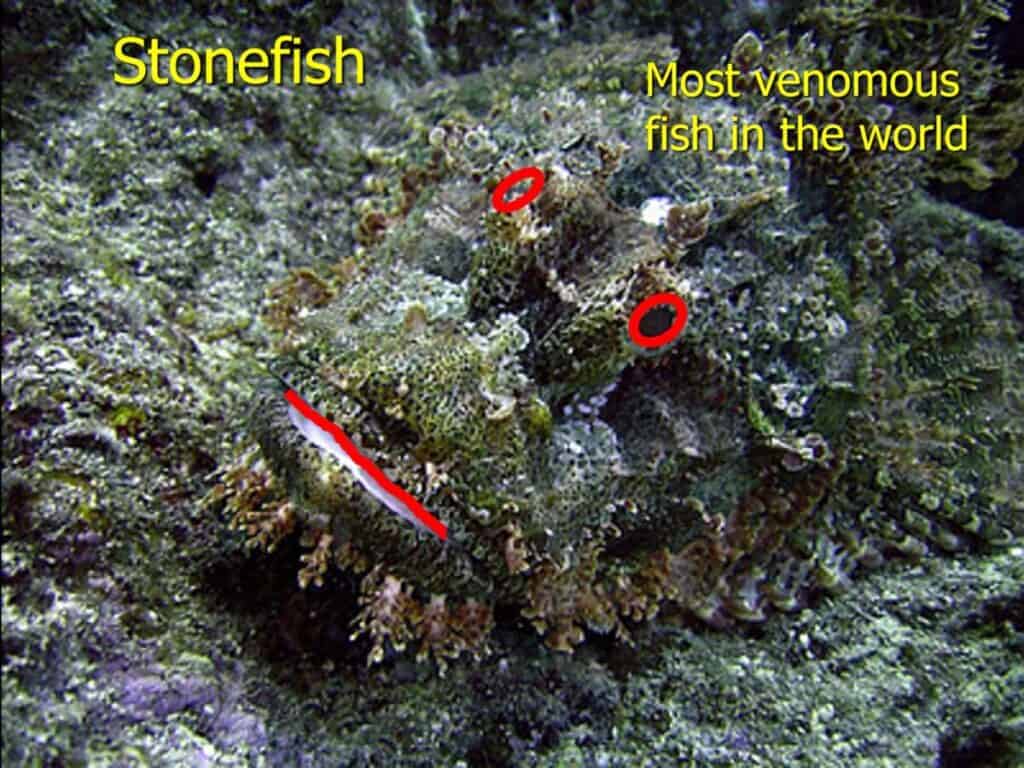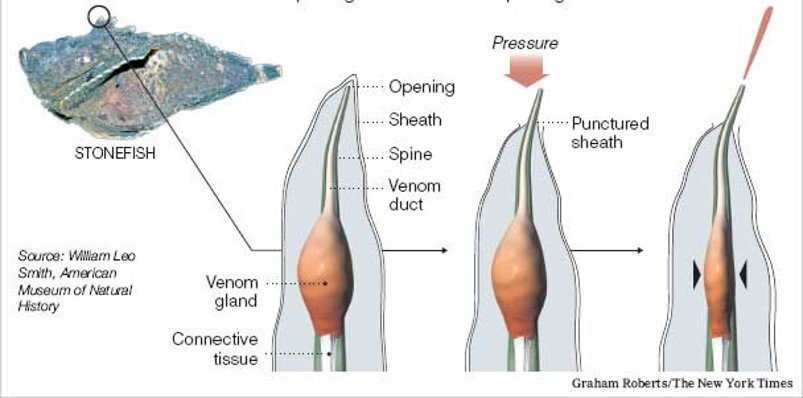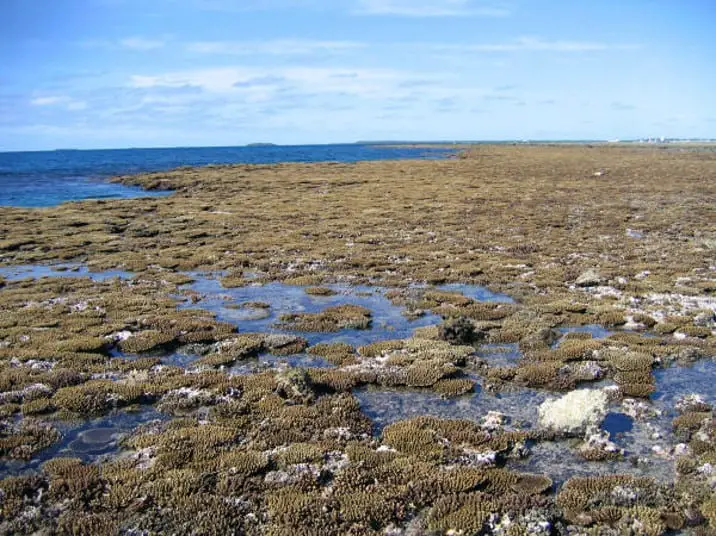Here’s one fish that I’m glad I’ve never encountered in its natural habitat! I’ve written this article in the hope that this information can help prevent accidental and potentially life-threatening encounters with the most venomous fish in the world.
The Stonefish is the most venomous fish in the ocean and many people have died after getting stung by one. The biggest danger is accidentally stepping on one since they are almost invisible at low tide. Needle-sharp spines can inject a toxic venom that can cause excruciating pain and potentially even death. Originally native to the Pacific and Indian Ocean, they are now found throughout Florida waters and the Caribbean.
Getting stung by a stonefish can cause excruciating pain. According to the National Institutes of Health in the USA “stonefish are one of the most venomous fish in the world with potential fatal local and systemic toxicity effects to humans.” Even if treated promptly, recovery from a stonefish sting “usually takes about 24 to 48 hours.”
There are roughly 800 to 1,000 stings reported every year in Australia alone, and stonefish are the likely cause of death for many people living on the shores of the Pacific and Indian Oceans. Now that they have been introduced to Florida and the Caribbean, they are considered the most dangerous fish in that region as well.
There are five species of stonefish throughout the world, with an average length of 30 to 40 cm (12-16 in) and up to 2 kg (5 lbs) in weight.
What Makes Stonefish Invisible?
The stonefish is a master at making itself invisible by blending in with its surroundings. You could easily step on a stonefish at low tide because they are so well-camouflaged that you would have little likelihood of seeing one in time.
Use extreme caution while walking on tidal flats or splashing through water at low tide. Please remember – these creatures are so well camouflaged that they are almost invisible in their native habitat. They are also capable of sitting exposed to the air for several hours during low tide, so you could find yourself stepping on a fish that is out of the water! A very painful and potentially deadly experience!
I urge you to use extreme caution walking on exposed tidal flats any place stonefish can be found. Ask the locals – if stonefish live nearby they will likely have some scary stories to tell!
In my science presentations on board cruise ships I like to give people a bit of a heads up concerning some of the dangers they might face, especially in tropical waters (for example, see my article on the potentially deadly Irukandji jellyfish).
I often show audiences a photograph of a stonefish lying on the sea bottom among the rocks and coral. Even after I tell folks they are looking at a stonefish, they have trouble seeing it. Only after I draw the outline of the fish and its eyes and mouth do they exclaim, “Yes, I finally see it!”

How is the Venom Injected?
Each of the thirteen needle-sharp spines along the dorsal fin is a hollow tube that acts like a hypodermic needle with its own venom sac.

Source: William Smith, American Museum of Natural History.
When the animal is disturbed, it raises its dorsal spines vertically as a defense mechanism. A human foot stepping down on the needle-sharp spines would put pressure on the venom sacs, shooting a steady stream of venom out through the ends of the spines directly into the foot.
The following video by National Geographic provides a dramatic presentation of the hypodermic action of one of the spines as it shoots venom into the air.
What Should You Do if Stung by a Stonefish?
A stonefish sting is a medical emergency!
If you step on something sharp at low tide or in the ocean check your foot immediately. It might be a piece of coral or sharp piece of broken shell. If there’s no sign of anything sharp, check the bottom of your foot. If you see a red dot or prick point that is painful and possibly oozing blood, look for medical attention and ask for help ASAP. Time is of the essence if it is a stonefish sting. By all reports, the pain becomes more intense within minutes to the extent that you can become immobilized with the pain.
Very hot water (not scalding) is recommended to relieve the pain, but in every case, you should seek medical attention. Mt Sinai hospital recommends soaking the wound in “the hottest water the person can tolerate for 30 to 90 minutes.”
Severe pain is not your only concern, the venom can also cause heart failure and even death if left untreated. Antivenin is usually considered essential.
The outcome from a sting depends on how much venom was injected, the location of the sting, and how quickly the person received medical treatment. Numbness or tingling may last for several weeks after a sting and sometimes tissue breakdown can require surgery. For the very unlucky, retained spines, persistent pain, and chronic neuropathy are also possible consequences.
This article is provided for information purposes only. Do not attempt to treat or manage a stonefish sting on your own. If you or someone else is stung, call your local emergency number (such as 911) immediately.
Is there an Antivenin or Antiserum?
Stonefish venom not only causes intense pain, but it can severely damage human tissue and potentially cause serious illness. Fortunately, an antivenin was developed in 1959 that is effective in reducing the likelihood of death. Not only is it effective for neutralizing the toxins, but it also helps prevent dangerous illness, and reduces the pain and swelling.
In most cases, the pain and swelling of a stonefish sting is so severe that antivenin is required to control these effects.
Do Stonefish Use Venom to Capture Prey?
You might think that stonefish use their toxic venom supply to capture prey, but the venom is used strictly for defense. Stonefish are ambush feeders that lie completely still on the bottom, waiting for an unsuspecting fish to swim close by. When the prey gets close enough the stonefish acts with lightning speed, opening its giant mouth and sucking the prey in with a gulping action. The attack is over in less than a second, and often as quickly as 0.015 seconds!
Interested in another fish that can devour its prey at lightning speed? An electric eel can immobilize its prey using its awesome electrical charge of over 600 volts!
Where do Stonefish live?
Stonefish were originally found in the tropical waters of the Pacific and Indian Oceans, including Asia, Australia and the islands.
Somehow, they have been introduced to Florida waters as well as the Caribbean!

Stonefish live in a variety of habitats. They look like lumps of algae covered rock or coral, so one of the best places to find them is hidden among rocks and coral, especially at low tide.
Watch this great video by Smarter Every Day showing venom shooting out of a stonefish’s spine!
References:
Rensch G, Murphy-Lavoie HM. Lionfish, Scorpionfish, And Stonefish Toxicity. [Updated 2020 Aug 25]. In: StatPearls [Internet]. Treasure Island (FL): StatPearls Publishing; 2020 Jan-. Available from: https://www.ncbi.nlm.nih.gov/books/NBK482204
Check Out Our TOP Articles for Even More Fascinating Creatures
- How do Octopus Reproduce? (Cannibalistic Sex, Detachable Penis)
- Do Jellyfish have Brains? How Can they Hunt without Brains?
- Why are Deep Sea Fish So Weird and Ugly? Warning: Scary Pictures!
- How do Snakes Mate? (Snake Reproduction Videos and Diagrams) Warning – Graphic Images
- Are Komodo Dragons Dangerous? Where Can you See Them?
- How Do Komodo Dragons Reproduce? (Forked Penises, Sperm Optional)
- Koala Brains – Why Being Dumb Can Be Smart (Natural Selection)
- Why do Lions Have Manes? (Do Dark Manes Mean More Sex?)
- How Do Lions Communicate? (Why Do Lions Roar?)
- How Dangerous are Stonefish? Can You Die if You Step on One?
- What Do Animals Do When They Hibernate? How do they Survive?
- Leaf Cutter Ants – Surprising Facts and Adaptations; Pictures and Videos
- Irukandji Jellyfish Facts and Adaptations; Can They Kill You? Are they spreading?
- How to See MORE Wildlife in the Amazon: 10 Practical Tips
- Is it Safe to go on Safari with Africa’s Top Predators and Most Dangerous Animals?
- What to Do if You Encounter a Bullet Ant? World’s Most Painful Stinging Insect!
- How Do Anglerfish Mate? Endless Sex or Die Trying!
- How Smart are Crocodiles? Can They Cooperate, Communicate…Use Tools?
- How Can We Save Our Oceans? With Marine Sanctuaries!
- Why Are Male Birds More Colorful? Ins and Outs of Sexual Selection Made Easy!
- Why is the Cassowary the Most Dangerous Bird in the World? 10 Facts
- How Do African Elephants Create Their Own Habitat?
- What is Killing Our Resident Orcas? Endangered Killer Whales
- Why are Animals of the Galapagos Islands Unique?
- Where Can You See Wild Lemurs in Madagascar? One of the Best Places
- Where Can You see Lyrebirds in the Wild? the Blue Mountains, Australia
- Keeping Mason Bees as Pets
- Why do Flamingos have Bent Beaks and Feed Upside Down?
- Why are Hippos Dangerous? (Do They Attack People?)

